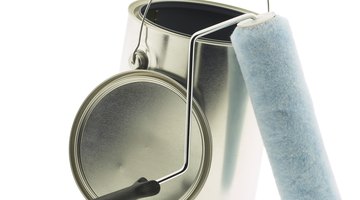How to Eliminate the Halo From Ceiling Paint Touch-Ups
A halo refers to visible applicator marks that don't match the existing painted surface.

These can result from brushing the edges and around light fixtures after the ceiling has been rolled, from using a brush or roller to touch-up a sprayed ceiling, or from applying a second coat of spray paint mixed to a different consistency than the first coat. Poor quality paints make it more difficult to seamlessly touch up a surface. Depending on the cause, eliminating a halo can be as easy as using the correct applicator, or in worst case scenarios, recoating the entire ceiling.
-
Wait at least 24 hours after you've done the touch-up before trying to eliminate halo marks. Sometimes paint needs some time to dry and blend in, especially if the air is cool and humid, which can significantly retard drying time.
-
Use the same method of application for the paint touch-up. In other words, if the ceiling was rolled, use a roller to touch up; if the ceiling was sprayed, touch it up with a paint sprayer.
-
Run your hand over the halo and sand it down with a sanding sponge or 120-grit sandpaper if it feels rough. Some halo marks are caused by sprayed paint being applied too dry, which will look (and feel) like small raised speckles of paint, according to a Painting and Decorating Contractors of America fact sheet.
-
Thin the paint with either water or paint conditioner. Use up to a pint of water or conditioner per gallon of paint. Apply the thinned touch-up paint well beyond the margins of the halo mark to blend the new paint with the old.
-
Cut in (paint all the edges with a brush) before rolling a ceiling. Cutting in after the ceiling has been rolled often leaves visible brush marks, which will be visible as a halo around ceiling fixtures.
Things You Will Need
- Paint roller
- Paint sprayer
- Sanding sponge or sandpaper
- Paint conditioner
Tip
Use a good quality paint, even for painting ceilings. Low quality paint tends to be harder to touch up with. Purchase "mini rollers" for ceiling touch up. Some come with their own tiny plastic paint tray, and are convenient for small touch-ups. If the entire ceiling paint job looks uneven, or there are many halo marks, it's usually easiest to thin or condition the paint and do another coat over the whole surface.
References
Writer Bio
Stevie Donald has been an online writer since 2004, producing articles for numerous websites and magazines. Her writing chops include three books on dog care and training, one of which won a prestigious national award in 2003. Donald has also been a painting contractor since 1979, painting interiors and exteriors.
Photo Credits
- Hemera Technologies/PhotoObjects.net/Getty Images
- Hemera Technologies/PhotoObjects.net/Getty Images
More Articles



